Reflective Journal: Indigenous Knowledge and Education (EDUC7510)
VerifiedAdded on 2023/06/04
|8
|1773
|484
Journal and Reflective Writing
AI Summary
This reflective journal, completed for the EDUC7510 Indigenous Knowledge and Education course, analyzes the student's learning journey through the application of the 5Rs framework (Reporting, Responding, Relating, Reasoning, and Reconstructing). The assignment explores the student's evolving understanding of Indigenous cultures, histories, and the impact of educational practices on Indigenous communities. It reflects on lectures, tutorials, readings, and online materials, integrating relevant theories to critically examine the student's social positioning and its influence on their perspectives. The journal highlights the student's emotional responses to the material, the development of their teaching philosophy, and their commitment to fostering equality and positive relationships in future educational settings. The student also discusses the application of theories, like social reasoning and categorization, to address issues affecting Indigenous populations and proposes future actions, such as creating a book, to promote unity and understanding between Indigenous and non-Indigenous communities. The journal demonstrates a deep engagement with the course content and a commitment to applying the acquired knowledge to improve teaching practices and contribute to social justice.
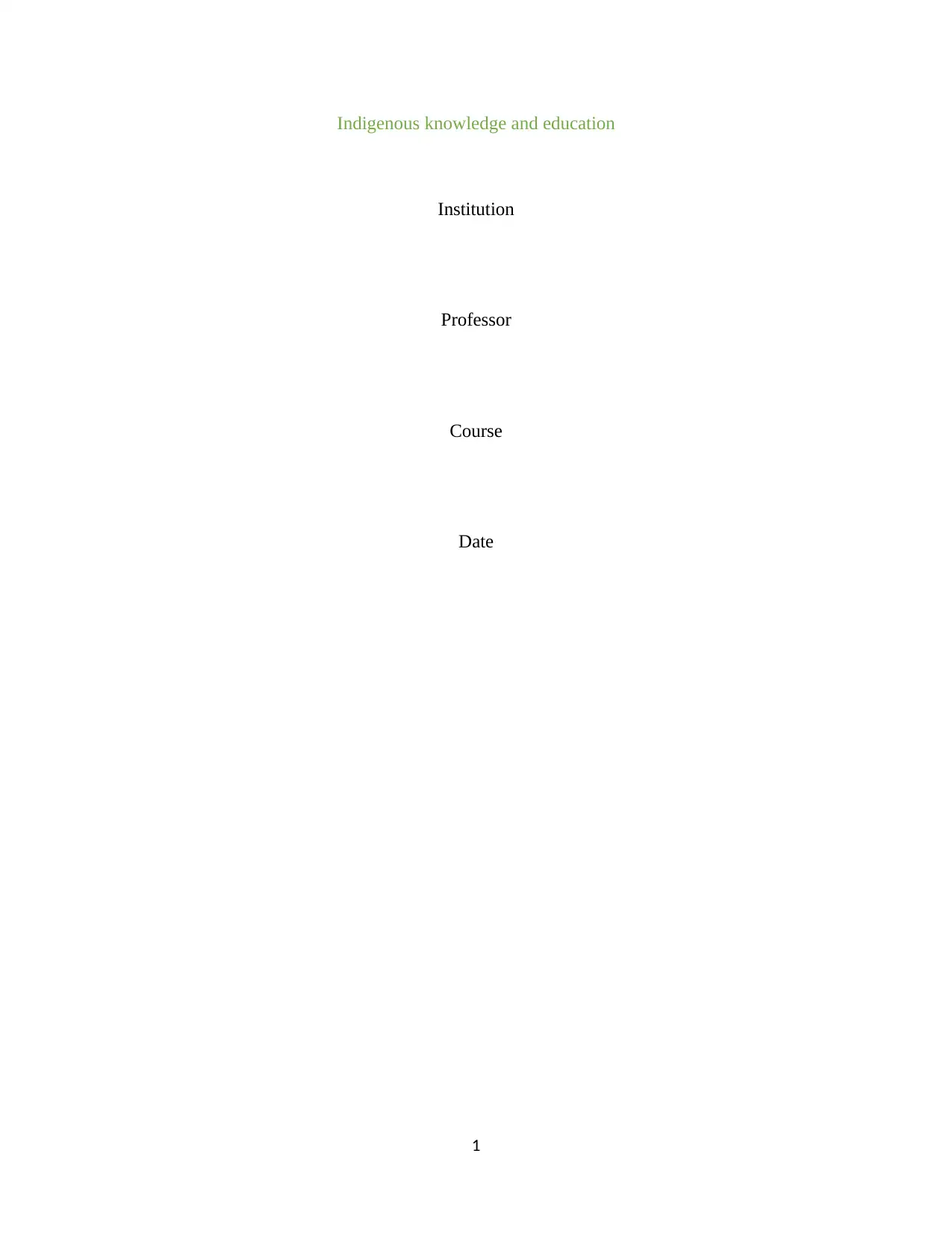
Indigenous knowledge and education
Institution
Professor
Course
Date
1
Institution
Professor
Course
Date
1
Paraphrase This Document
Need a fresh take? Get an instant paraphrase of this document with our AI Paraphraser
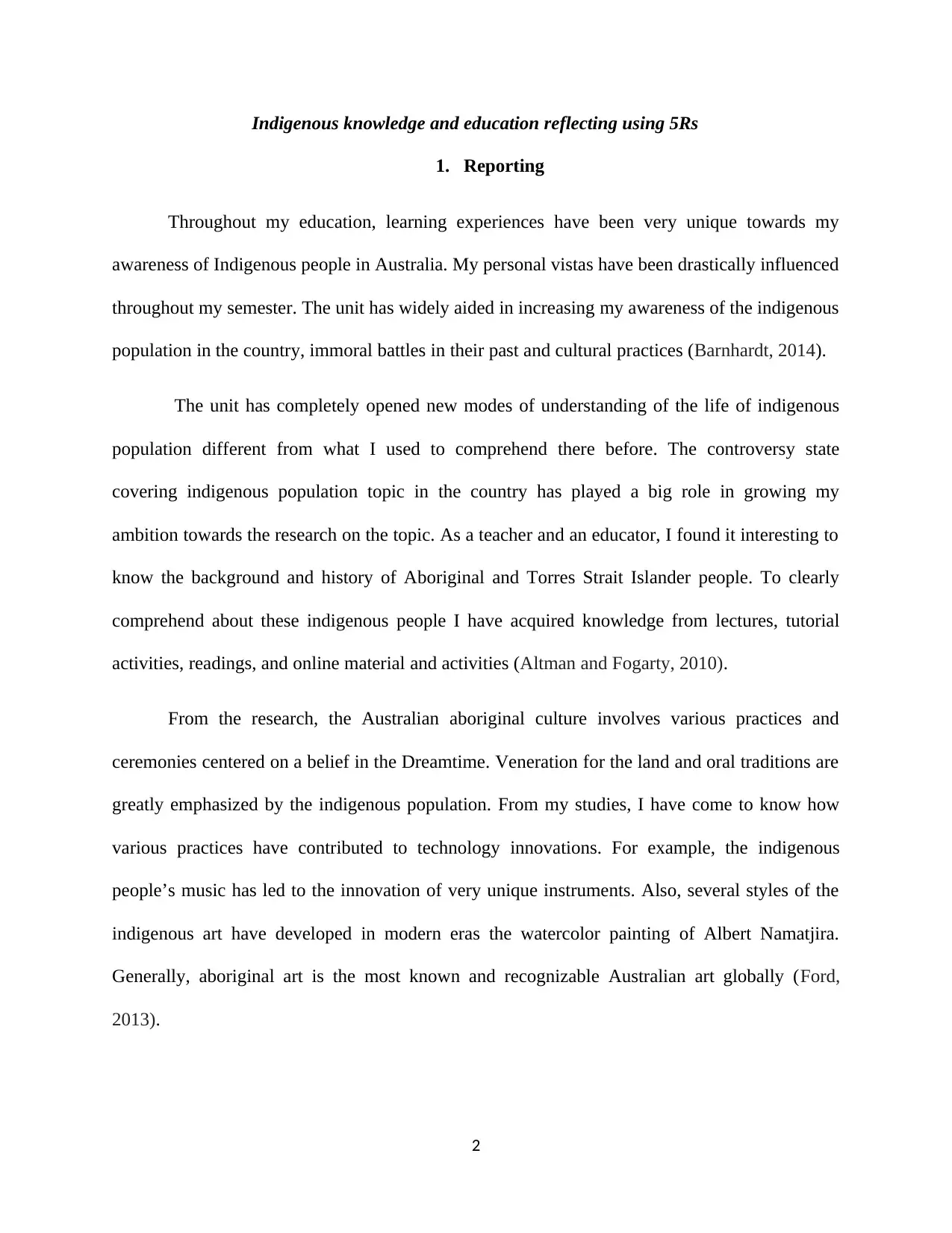
Indigenous knowledge and education reflecting using 5Rs
1. Reporting
Throughout my education, learning experiences have been very unique towards my
awareness of Indigenous people in Australia. My personal vistas have been drastically influenced
throughout my semester. The unit has widely aided in increasing my awareness of the indigenous
population in the country, immoral battles in their past and cultural practices (Barnhardt, 2014).
The unit has completely opened new modes of understanding of the life of indigenous
population different from what I used to comprehend there before. The controversy state
covering indigenous population topic in the country has played a big role in growing my
ambition towards the research on the topic. As a teacher and an educator, I found it interesting to
know the background and history of Aboriginal and Torres Strait Islander people. To clearly
comprehend about these indigenous people I have acquired knowledge from lectures, tutorial
activities, readings, and online material and activities (Altman and Fogarty, 2010).
From the research, the Australian aboriginal culture involves various practices and
ceremonies centered on a belief in the Dreamtime. Veneration for the land and oral traditions are
greatly emphasized by the indigenous population. From my studies, I have come to know how
various practices have contributed to technology innovations. For example, the indigenous
people’s music has led to the innovation of very unique instruments. Also, several styles of the
indigenous art have developed in modern eras the watercolor painting of Albert Namatjira.
Generally, aboriginal art is the most known and recognizable Australian art globally (Ford,
2013).
2
1. Reporting
Throughout my education, learning experiences have been very unique towards my
awareness of Indigenous people in Australia. My personal vistas have been drastically influenced
throughout my semester. The unit has widely aided in increasing my awareness of the indigenous
population in the country, immoral battles in their past and cultural practices (Barnhardt, 2014).
The unit has completely opened new modes of understanding of the life of indigenous
population different from what I used to comprehend there before. The controversy state
covering indigenous population topic in the country has played a big role in growing my
ambition towards the research on the topic. As a teacher and an educator, I found it interesting to
know the background and history of Aboriginal and Torres Strait Islander people. To clearly
comprehend about these indigenous people I have acquired knowledge from lectures, tutorial
activities, readings, and online material and activities (Altman and Fogarty, 2010).
From the research, the Australian aboriginal culture involves various practices and
ceremonies centered on a belief in the Dreamtime. Veneration for the land and oral traditions are
greatly emphasized by the indigenous population. From my studies, I have come to know how
various practices have contributed to technology innovations. For example, the indigenous
people’s music has led to the innovation of very unique instruments. Also, several styles of the
indigenous art have developed in modern eras the watercolor painting of Albert Namatjira.
Generally, aboriginal art is the most known and recognizable Australian art globally (Ford,
2013).
2
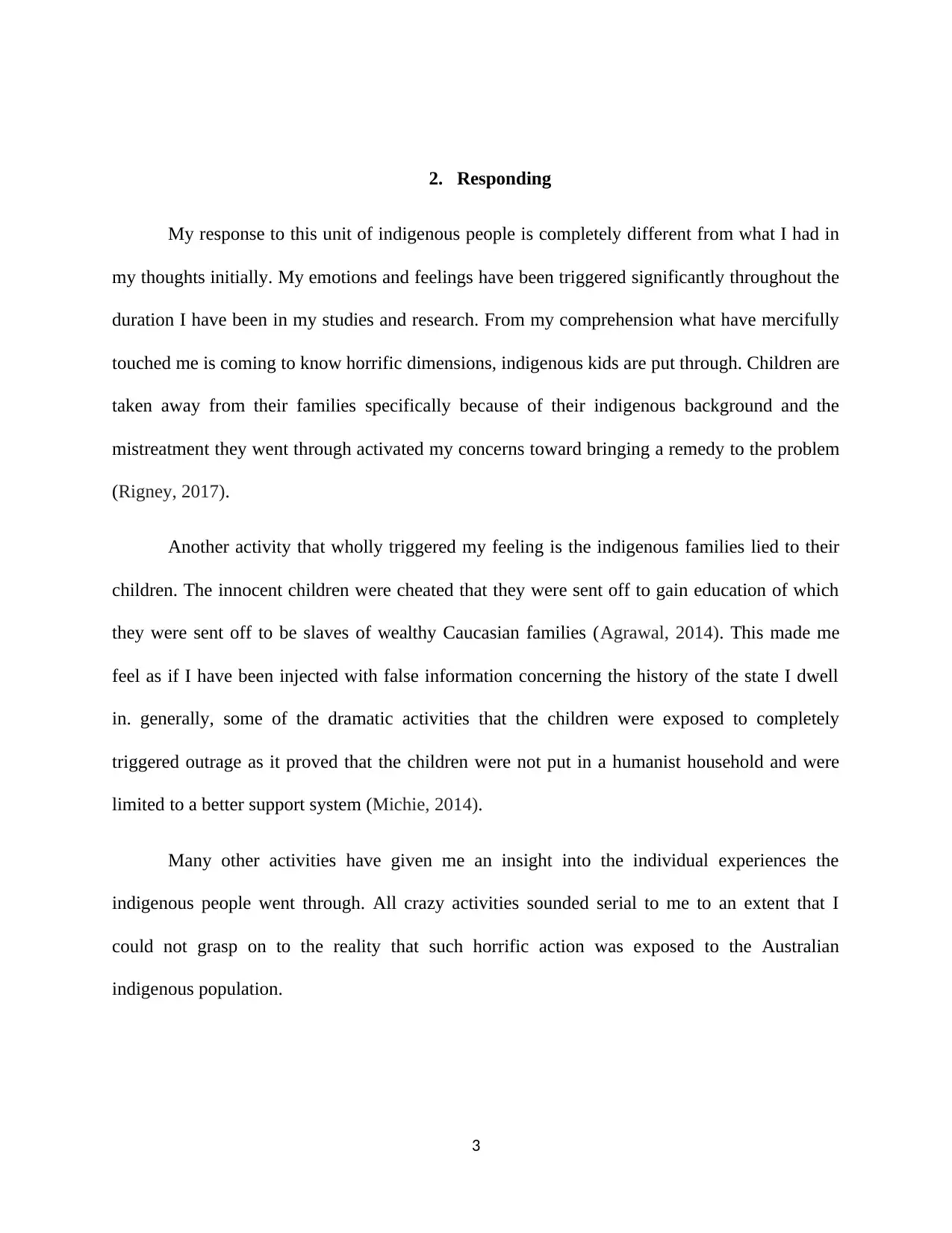
2. Responding
My response to this unit of indigenous people is completely different from what I had in
my thoughts initially. My emotions and feelings have been triggered significantly throughout the
duration I have been in my studies and research. From my comprehension what have mercifully
touched me is coming to know horrific dimensions, indigenous kids are put through. Children are
taken away from their families specifically because of their indigenous background and the
mistreatment they went through activated my concerns toward bringing a remedy to the problem
(Rigney, 2017).
Another activity that wholly triggered my feeling is the indigenous families lied to their
children. The innocent children were cheated that they were sent off to gain education of which
they were sent off to be slaves of wealthy Caucasian families (Agrawal, 2014). This made me
feel as if I have been injected with false information concerning the history of the state I dwell
in. generally, some of the dramatic activities that the children were exposed to completely
triggered outrage as it proved that the children were not put in a humanist household and were
limited to a better support system (Michie, 2014).
Many other activities have given me an insight into the individual experiences the
indigenous people went through. All crazy activities sounded serial to me to an extent that I
could not grasp on to the reality that such horrific action was exposed to the Australian
indigenous population.
3
My response to this unit of indigenous people is completely different from what I had in
my thoughts initially. My emotions and feelings have been triggered significantly throughout the
duration I have been in my studies and research. From my comprehension what have mercifully
touched me is coming to know horrific dimensions, indigenous kids are put through. Children are
taken away from their families specifically because of their indigenous background and the
mistreatment they went through activated my concerns toward bringing a remedy to the problem
(Rigney, 2017).
Another activity that wholly triggered my feeling is the indigenous families lied to their
children. The innocent children were cheated that they were sent off to gain education of which
they were sent off to be slaves of wealthy Caucasian families (Agrawal, 2014). This made me
feel as if I have been injected with false information concerning the history of the state I dwell
in. generally, some of the dramatic activities that the children were exposed to completely
triggered outrage as it proved that the children were not put in a humanist household and were
limited to a better support system (Michie, 2014).
Many other activities have given me an insight into the individual experiences the
indigenous people went through. All crazy activities sounded serial to me to an extent that I
could not grasp on to the reality that such horrific action was exposed to the Australian
indigenous population.
3
⊘ This is a preview!⊘
Do you want full access?
Subscribe today to unlock all pages.

Trusted by 1+ million students worldwide
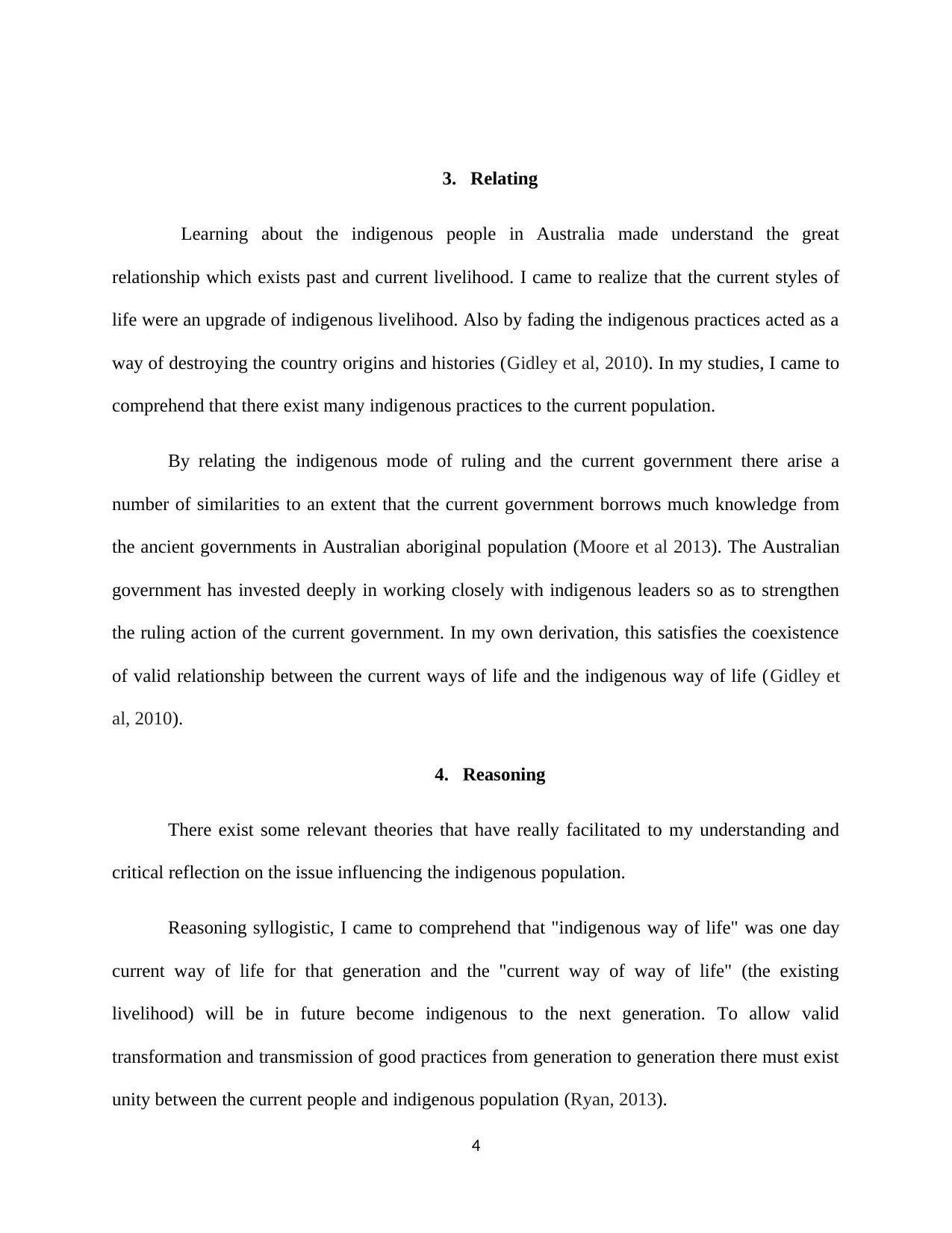
3. Relating
Learning about the indigenous people in Australia made understand the great
relationship which exists past and current livelihood. I came to realize that the current styles of
life were an upgrade of indigenous livelihood. Also by fading the indigenous practices acted as a
way of destroying the country origins and histories (Gidley et al, 2010). In my studies, I came to
comprehend that there exist many indigenous practices to the current population.
By relating the indigenous mode of ruling and the current government there arise a
number of similarities to an extent that the current government borrows much knowledge from
the ancient governments in Australian aboriginal population (Moore et al 2013). The Australian
government has invested deeply in working closely with indigenous leaders so as to strengthen
the ruling action of the current government. In my own derivation, this satisfies the coexistence
of valid relationship between the current ways of life and the indigenous way of life (Gidley et
al, 2010).
4. Reasoning
There exist some relevant theories that have really facilitated to my understanding and
critical reflection on the issue influencing the indigenous population.
Reasoning syllogistic, I came to comprehend that "indigenous way of life" was one day
current way of life for that generation and the "current way of way of life" (the existing
livelihood) will be in future become indigenous to the next generation. To allow valid
transformation and transmission of good practices from generation to generation there must exist
unity between the current people and indigenous population (Ryan, 2013).
4
Learning about the indigenous people in Australia made understand the great
relationship which exists past and current livelihood. I came to realize that the current styles of
life were an upgrade of indigenous livelihood. Also by fading the indigenous practices acted as a
way of destroying the country origins and histories (Gidley et al, 2010). In my studies, I came to
comprehend that there exist many indigenous practices to the current population.
By relating the indigenous mode of ruling and the current government there arise a
number of similarities to an extent that the current government borrows much knowledge from
the ancient governments in Australian aboriginal population (Moore et al 2013). The Australian
government has invested deeply in working closely with indigenous leaders so as to strengthen
the ruling action of the current government. In my own derivation, this satisfies the coexistence
of valid relationship between the current ways of life and the indigenous way of life (Gidley et
al, 2010).
4. Reasoning
There exist some relevant theories that have really facilitated to my understanding and
critical reflection on the issue influencing the indigenous population.
Reasoning syllogistic, I came to comprehend that "indigenous way of life" was one day
current way of life for that generation and the "current way of way of life" (the existing
livelihood) will be in future become indigenous to the next generation. To allow valid
transformation and transmission of good practices from generation to generation there must exist
unity between the current people and indigenous population (Ryan, 2013).
4
Paraphrase This Document
Need a fresh take? Get an instant paraphrase of this document with our AI Paraphraser
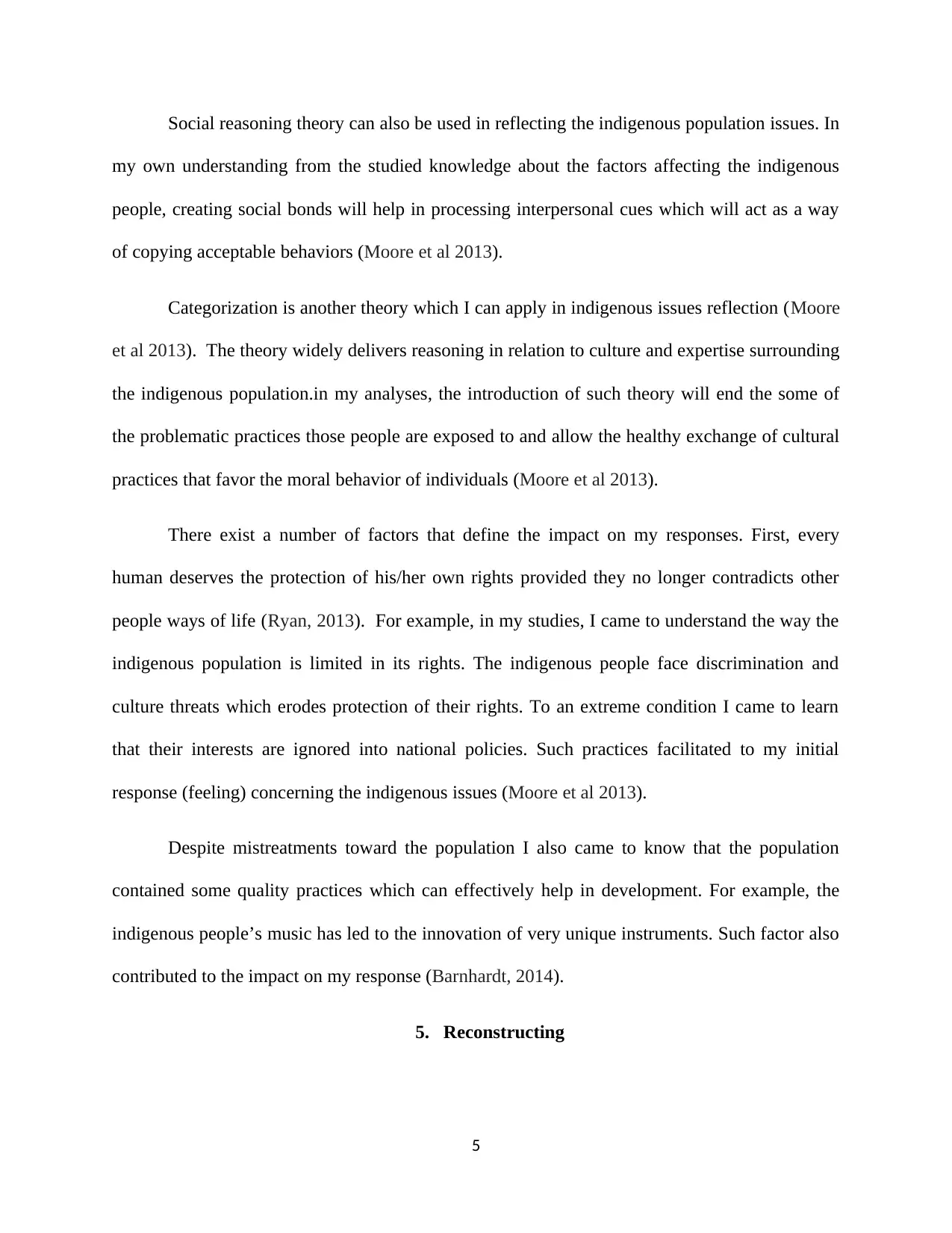
Social reasoning theory can also be used in reflecting the indigenous population issues. In
my own understanding from the studied knowledge about the factors affecting the indigenous
people, creating social bonds will help in processing interpersonal cues which will act as a way
of copying acceptable behaviors (Moore et al 2013).
Categorization is another theory which I can apply in indigenous issues reflection (Moore
et al 2013). The theory widely delivers reasoning in relation to culture and expertise surrounding
the indigenous population.in my analyses, the introduction of such theory will end the some of
the problematic practices those people are exposed to and allow the healthy exchange of cultural
practices that favor the moral behavior of individuals (Moore et al 2013).
There exist a number of factors that define the impact on my responses. First, every
human deserves the protection of his/her own rights provided they no longer contradicts other
people ways of life (Ryan, 2013). For example, in my studies, I came to understand the way the
indigenous population is limited in its rights. The indigenous people face discrimination and
culture threats which erodes protection of their rights. To an extreme condition I came to learn
that their interests are ignored into national policies. Such practices facilitated to my initial
response (feeling) concerning the indigenous issues (Moore et al 2013).
Despite mistreatments toward the population I also came to know that the population
contained some quality practices which can effectively help in development. For example, the
indigenous people’s music has led to the innovation of very unique instruments. Such factor also
contributed to the impact on my response (Barnhardt, 2014).
5. Reconstructing
5
my own understanding from the studied knowledge about the factors affecting the indigenous
people, creating social bonds will help in processing interpersonal cues which will act as a way
of copying acceptable behaviors (Moore et al 2013).
Categorization is another theory which I can apply in indigenous issues reflection (Moore
et al 2013). The theory widely delivers reasoning in relation to culture and expertise surrounding
the indigenous population.in my analyses, the introduction of such theory will end the some of
the problematic practices those people are exposed to and allow the healthy exchange of cultural
practices that favor the moral behavior of individuals (Moore et al 2013).
There exist a number of factors that define the impact on my responses. First, every
human deserves the protection of his/her own rights provided they no longer contradicts other
people ways of life (Ryan, 2013). For example, in my studies, I came to understand the way the
indigenous population is limited in its rights. The indigenous people face discrimination and
culture threats which erodes protection of their rights. To an extreme condition I came to learn
that their interests are ignored into national policies. Such practices facilitated to my initial
response (feeling) concerning the indigenous issues (Moore et al 2013).
Despite mistreatments toward the population I also came to know that the population
contained some quality practices which can effectively help in development. For example, the
indigenous people’s music has led to the innovation of very unique instruments. Such factor also
contributed to the impact on my response (Barnhardt, 2014).
5. Reconstructing
5
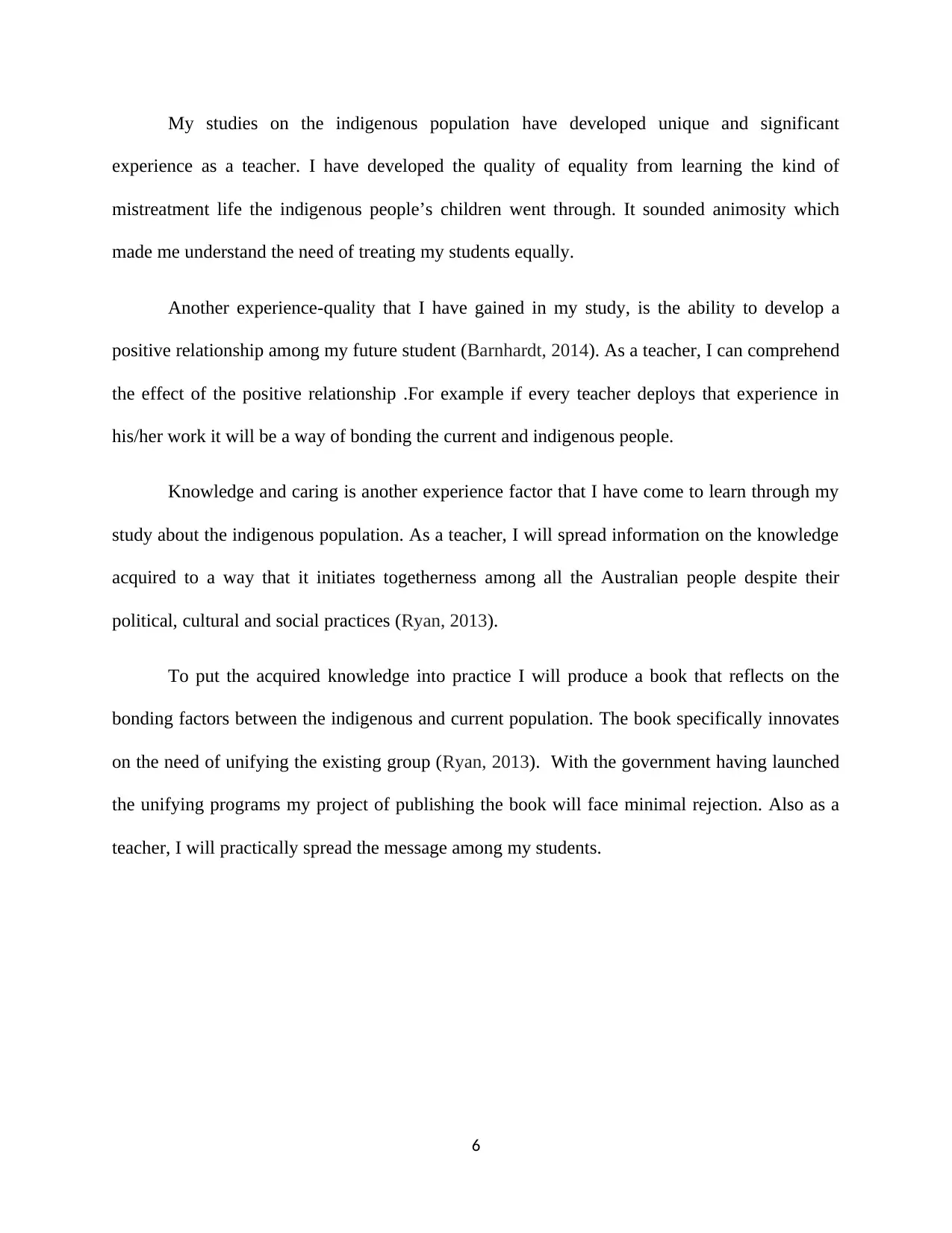
My studies on the indigenous population have developed unique and significant
experience as a teacher. I have developed the quality of equality from learning the kind of
mistreatment life the indigenous people’s children went through. It sounded animosity which
made me understand the need of treating my students equally.
Another experience-quality that I have gained in my study, is the ability to develop a
positive relationship among my future student (Barnhardt, 2014). As a teacher, I can comprehend
the effect of the positive relationship .For example if every teacher deploys that experience in
his/her work it will be a way of bonding the current and indigenous people.
Knowledge and caring is another experience factor that I have come to learn through my
study about the indigenous population. As a teacher, I will spread information on the knowledge
acquired to a way that it initiates togetherness among all the Australian people despite their
political, cultural and social practices (Ryan, 2013).
To put the acquired knowledge into practice I will produce a book that reflects on the
bonding factors between the indigenous and current population. The book specifically innovates
on the need of unifying the existing group (Ryan, 2013). With the government having launched
the unifying programs my project of publishing the book will face minimal rejection. Also as a
teacher, I will practically spread the message among my students.
6
experience as a teacher. I have developed the quality of equality from learning the kind of
mistreatment life the indigenous people’s children went through. It sounded animosity which
made me understand the need of treating my students equally.
Another experience-quality that I have gained in my study, is the ability to develop a
positive relationship among my future student (Barnhardt, 2014). As a teacher, I can comprehend
the effect of the positive relationship .For example if every teacher deploys that experience in
his/her work it will be a way of bonding the current and indigenous people.
Knowledge and caring is another experience factor that I have come to learn through my
study about the indigenous population. As a teacher, I will spread information on the knowledge
acquired to a way that it initiates togetherness among all the Australian people despite their
political, cultural and social practices (Ryan, 2013).
To put the acquired knowledge into practice I will produce a book that reflects on the
bonding factors between the indigenous and current population. The book specifically innovates
on the need of unifying the existing group (Ryan, 2013). With the government having launched
the unifying programs my project of publishing the book will face minimal rejection. Also as a
teacher, I will practically spread the message among my students.
6
⊘ This is a preview!⊘
Do you want full access?
Subscribe today to unlock all pages.

Trusted by 1+ million students worldwide
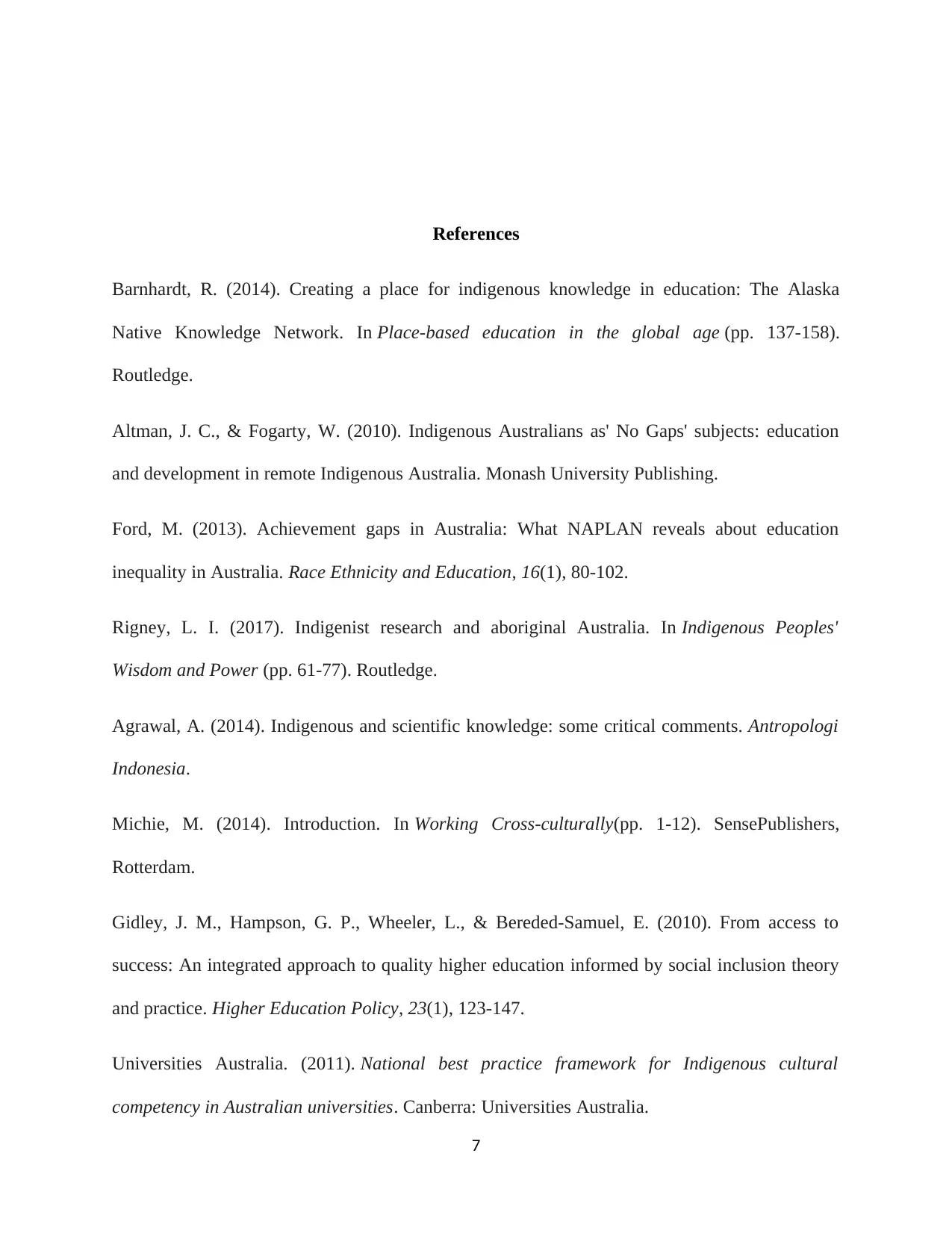
References
Barnhardt, R. (2014). Creating a place for indigenous knowledge in education: The Alaska
Native Knowledge Network. In Place-based education in the global age (pp. 137-158).
Routledge.
Altman, J. C., & Fogarty, W. (2010). Indigenous Australians as' No Gaps' subjects: education
and development in remote Indigenous Australia. Monash University Publishing.
Ford, M. (2013). Achievement gaps in Australia: What NAPLAN reveals about education
inequality in Australia. Race Ethnicity and Education, 16(1), 80-102.
Rigney, L. I. (2017). Indigenist research and aboriginal Australia. In Indigenous Peoples'
Wisdom and Power (pp. 61-77). Routledge.
Agrawal, A. (2014). Indigenous and scientific knowledge: some critical comments. Antropologi
Indonesia.
Michie, M. (2014). Introduction. In Working Cross-culturally(pp. 1-12). SensePublishers,
Rotterdam.
Gidley, J. M., Hampson, G. P., Wheeler, L., & Bereded-Samuel, E. (2010). From access to
success: An integrated approach to quality higher education informed by social inclusion theory
and practice. Higher Education Policy, 23(1), 123-147.
Universities Australia. (2011). National best practice framework for Indigenous cultural
competency in Australian universities. Canberra: Universities Australia.
7
Barnhardt, R. (2014). Creating a place for indigenous knowledge in education: The Alaska
Native Knowledge Network. In Place-based education in the global age (pp. 137-158).
Routledge.
Altman, J. C., & Fogarty, W. (2010). Indigenous Australians as' No Gaps' subjects: education
and development in remote Indigenous Australia. Monash University Publishing.
Ford, M. (2013). Achievement gaps in Australia: What NAPLAN reveals about education
inequality in Australia. Race Ethnicity and Education, 16(1), 80-102.
Rigney, L. I. (2017). Indigenist research and aboriginal Australia. In Indigenous Peoples'
Wisdom and Power (pp. 61-77). Routledge.
Agrawal, A. (2014). Indigenous and scientific knowledge: some critical comments. Antropologi
Indonesia.
Michie, M. (2014). Introduction. In Working Cross-culturally(pp. 1-12). SensePublishers,
Rotterdam.
Gidley, J. M., Hampson, G. P., Wheeler, L., & Bereded-Samuel, E. (2010). From access to
success: An integrated approach to quality higher education informed by social inclusion theory
and practice. Higher Education Policy, 23(1), 123-147.
Universities Australia. (2011). National best practice framework for Indigenous cultural
competency in Australian universities. Canberra: Universities Australia.
7
Paraphrase This Document
Need a fresh take? Get an instant paraphrase of this document with our AI Paraphraser
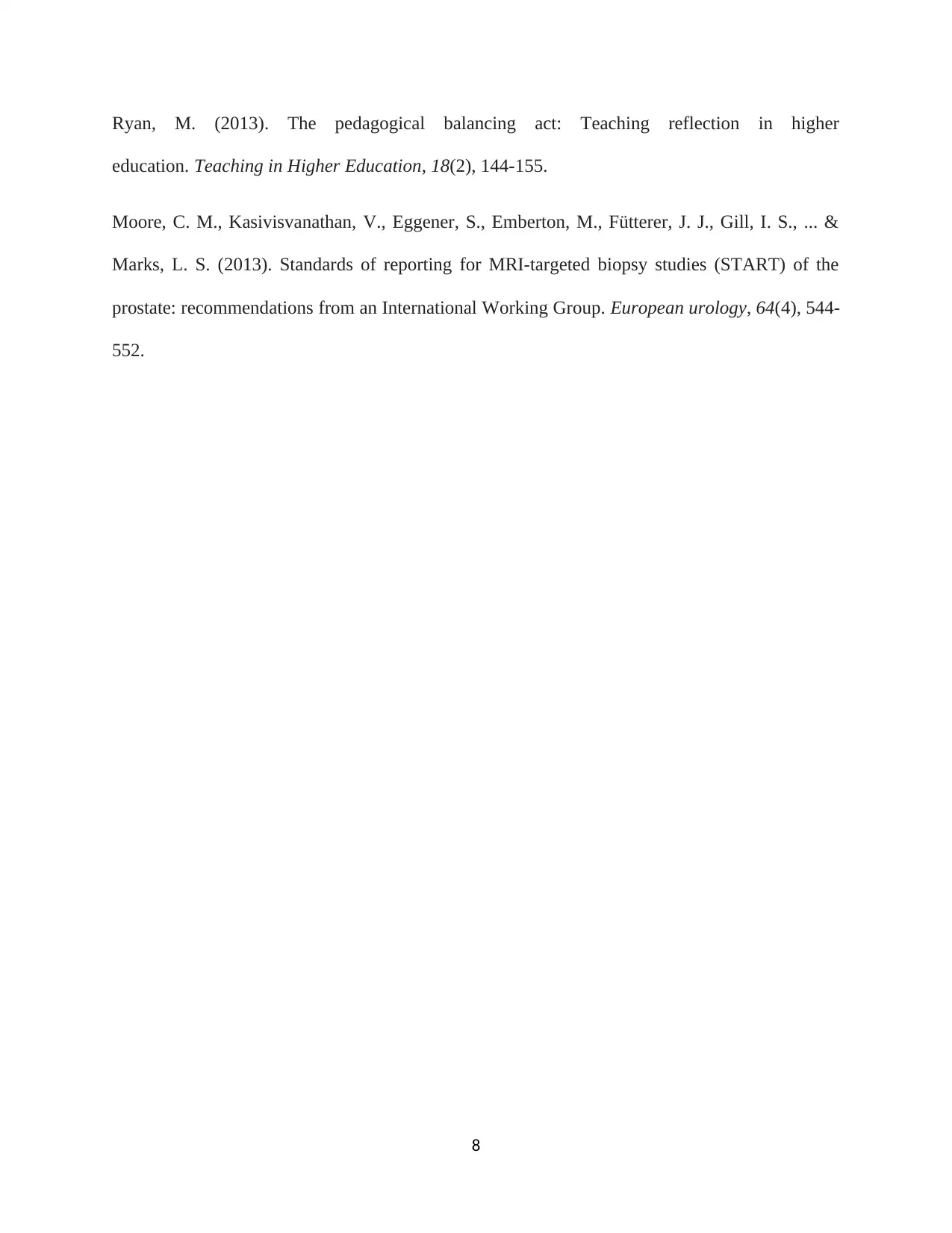
Ryan, M. (2013). The pedagogical balancing act: Teaching reflection in higher
education. Teaching in Higher Education, 18(2), 144-155.
Moore, C. M., Kasivisvanathan, V., Eggener, S., Emberton, M., Fütterer, J. J., Gill, I. S., ... &
Marks, L. S. (2013). Standards of reporting for MRI-targeted biopsy studies (START) of the
prostate: recommendations from an International Working Group. European urology, 64(4), 544-
552.
8
education. Teaching in Higher Education, 18(2), 144-155.
Moore, C. M., Kasivisvanathan, V., Eggener, S., Emberton, M., Fütterer, J. J., Gill, I. S., ... &
Marks, L. S. (2013). Standards of reporting for MRI-targeted biopsy studies (START) of the
prostate: recommendations from an International Working Group. European urology, 64(4), 544-
552.
8
1 out of 8
Related Documents
Your All-in-One AI-Powered Toolkit for Academic Success.
+13062052269
info@desklib.com
Available 24*7 on WhatsApp / Email
![[object Object]](/_next/static/media/star-bottom.7253800d.svg)
Unlock your academic potential
Copyright © 2020–2025 A2Z Services. All Rights Reserved. Developed and managed by ZUCOL.





